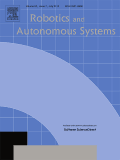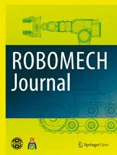
ROBOTICS AND AUTONOMOUS SYSTEMS
Scope & Guideline
Exploring Innovations in Robotics and Autonomy.
Introduction
Aims and Scopes
- Robotic Manipulation and Control:
Research on the development of advanced control strategies for robotic systems, including manipulation, trajectory tracking, and interaction with dynamic environments. - Autonomous Navigation and Path Planning:
Studies focusing on algorithms and techniques for enabling autonomous robots to navigate complex environments, including multi-agent systems and obstacle avoidance. - Human-Robot Interaction:
Exploration of methodologies for enhancing interactions between humans and robots, including collaborative tasks, user-centered design, and social robotics. - Reinforcement Learning and AI in Robotics:
Application of machine learning techniques, particularly reinforcement learning, to improve robotic decision-making, skill acquisition, and adaptability. - Robotics in Specialized Applications:
Research addressing specific applications of robotics, such as healthcare, agriculture, and disaster response, highlighting the practical implications of robotic technologies. - Sensor Fusion and Perception Systems:
Innovations in integrating various sensors to enhance robot perception, enabling better environmental understanding and interaction. - Swarm Robotics and Multi-Robot Systems:
Investigation into cooperative behaviors and task allocation strategies for groups of robots, emphasizing decentralized control and communication.
Trending and Emerging
- Deep Learning and Neural Networks:
An increasing number of studies are leveraging deep learning techniques for various robotic applications, including perception, control, and decision-making, emphasizing the transformative role of AI in robotics. - Adaptive and Intelligent Robotics:
Research focusing on adaptive systems that can learn and adjust to changing environments and tasks is on the rise, showcasing the movement towards more intelligent and autonomous robots. - Robotics in Healthcare:
There is a growing emphasis on the application of robotics in healthcare settings, particularly in rehabilitation and assistive technologies, driven by the need for innovative solutions in patient care. - Collaborative Robotics (Cobots):
The rise of collaborative robots designed to work alongside humans in various settings is gaining traction, highlighting the importance of safety and efficiency in human-robot collaboration. - Robotics for Environmental Monitoring:
Emerging research is focusing on the use of robotics for environmental applications, such as precision agriculture and disaster response, reflecting a commitment to addressing global challenges. - Multi-Agent Systems and Swarm Intelligence:
There is a notable increase in research related to multi-agent systems and swarm robotics, emphasizing collective behaviors and decentralized control for complex tasks.
Declining or Waning
- Traditional Robotics Techniques:
As the field advances, traditional control methods and simple robotic designs are becoming less emphasized in favor of more complex, adaptive systems that utilize AI and machine learning. - Static Path Planning Approaches:
There is a noticeable reduction in focus on conventional path planning methods that do not account for dynamic environments, with a shift towards more adaptive and predictive techniques. - Basic Sensor Technologies:
Research centered on basic sensor technologies is declining as more sophisticated and integrated sensor systems are being developed, leading to an increased focus on sensor fusion and advanced perception. - Manual Programming of Robots:
The trend is moving away from manual programming techniques towards more automated and intelligent systems that rely on learning from demonstrations and user interactions. - Low-Level Control Systems:
There is a diminishing interest in low-level control systems that do not incorporate higher-level decision-making processes, as the focus shifts towards more holistic, intelligent approaches.
Similar Journals

Frontiers in Robotics and AI
Fostering Collaboration in the World of Robotics and AIFrontiers in Robotics and AI is a leading journal dedicated to the exploration and dissemination of groundbreaking research in the fields of robotics and artificial intelligence. Published by FRONTIERS MEDIA SA in Switzerland, it has established itself as a vital resource for academics, professionals, and students since its inception in 2014. With an impressive Open Access model, the journal ensures that high-quality research is accessible to a global audience, fostering collaboration and innovation. The journal is recognized for its distinguished impact in the academic community, achieving Q2 quartile rankings in both Artificial Intelligence and Computer Science Applications as of 2023. It currently holds a solid position in Scopus rankings, with a rank of #123 out of 350 in Artificial Intelligence and #223 out of 817 in Computer Science Applications, reflecting its robust contribution to these dynamic disciplines. The journal's scope encompasses a wide range of topics, including but not limited to autonomous systems, machine learning, and human-robot interaction, making it an essential platform for innovative ideas and advanced research.

Artificial Life and Robotics
Pioneering Interdisciplinary Studies in AI and RoboticsArtificial Life and Robotics, published by Springer, is a prominent journal in the fields of Artificial Intelligence and Biochemistry, Genetics, and Molecular Biology, with an ISSN of 1433-5298 and E-ISSN of 1614-7456. Established in 2005, the journal has continually contributed to knowledge and innovation in these rapidly evolving disciplines and is recognized for its significant impact, as indicated by its quartile rankings in the 2023 category assessments. The journal is currently positioned in Q4 for Artificial Intelligence and Q3 for General Biochemistry, Genetics and Molecular Biology, with a notable ranking of 138/221 and 262/350 in respective research areas. While it currently does not follow an open access model, it remains a valuable resource for researchers, professionals, and students seeking to advance their understanding and application of artificial life and robotic technologies. With an emphasis on interdisciplinary research, this journal aims to bridge theoretical foundations with practical applications, making it an essential platform for cutting-edge studies and discussions in the field.

INTERNATIONAL JOURNAL OF ROBOTICS RESEARCH
Advancing the Frontiers of Robotics ResearchINTERNATIONAL JOURNAL OF ROBOTICS RESEARCH (ISSN: 0278-3649, E-ISSN: 1741-3176), published by SAGE PUBLICATIONS LTD, is a leading journal in the fields of robotics and engineering. With an impressive impact factor and recognized as a Q1 journal in various categories including Applied Mathematics, Artificial Intelligence, Electrical and Electronic Engineering, Mechanical Engineering, Modeling and Simulation, and Software, it has established itself as an essential resource for researchers and practitioners alike. The journal covers a wide array of topics relevant to the advancing disciplines of robotics, ensuring comprehensive perspectives on both theoretical and practical applications. Notably, it ranks at the top percentile in Scopus rankings across multiple fields, which underscores its significance in the research community. Published continuously since 1982, the journal invites submissions that push the boundaries of robotics research, offering a platform for innovative ideas and solutions that address complex engineering problems. While it operates under a subscription model, its vast reach and reputation make it an invaluable resource for advancing knowledge in robotics.

ROBOMECH Journal
Connecting Scholars and Innovators in Robotics and AIROBOMECH Journal, published by SpringerNature, is a prominent open-access journal dedicated to the fields of robotics, mechanical engineering, and artificial intelligence. Established in 2014, the journal has quickly established itself as a vital platform for disseminating innovative research in control and optimization, instrumentation, and modeling and simulation, earning a commendable Q2 ranking in Mechanical Engineering and multiple Q3 rankings across other relevant fields in 2023. With a commitment to facilitating accessible knowledge sharing, ROBOMECH Journal promotes cutting-edge research that drives advancements in both theoretical frameworks and practical applications within the robotics community. Scholars, engineers, and professionals seeking to contribute to or stay informed about the latest developments in these dynamic fields will find the journal's rich array of articles invaluable. With its open-access model, all published research is freely available, ensuring wide dissemination and increased visibility for authors, thus fostering collaboration and innovation across disciplines.

Science Robotics
Driving Progress in Mechanical Engineering and AIScience Robotics, published by the American Association for the Advancement of Science, is a leading journal that explores cutting-edge advancements in the field of robotics, emphasizing the intersection of artificial intelligence, mechanical engineering, and control optimization. With its ISSN 2470-9476, this prestigious journal holds an impressive Q1 ranking across pivotal categories for 2023, including Artificial Intelligence, Computer Science Applications, Control and Optimization, and Mechanical Engineering. It has garnered renowned recognition in the academic community, highlighted by its high Scopus rankings—placing it in the top tier with a 99th percentile rank in Mathematics for Control and Optimization and Computer Science Applications, and maintaining a 98th percentile in Artificial Intelligence. While the journal is not currently open access, it serves as a vital repository of knowledge for researchers, professionals, and students seeking to stay at the forefront of robotic innovations. Operating from its base in Washington, DC, Science Robotics aims to disseminate world-class research that catalyzes future developments in robotics and automation technologies, making it an essential resource for those engaged in the scientific study and application of these transformative fields.

Robotics, published by MDPI in Switzerland, stands at the forefront of interdisciplinary research, focusing on the latest advancements in robotics, artificial intelligence, control systems, and mechanical engineering. As an Open Access journal since 2012, it aims to disseminate high-quality research and innovative findings to a global audience, promoting collaboration among researchers, professionals, and students alike. With a commendable impact reflected in its 2023 categorizations—including Q2 rankings in Artificial Intelligence and Control and Optimization, and a prestigious Q1 in Mechanical Engineering—the journal underscores its significance within the scientific community. Notably, it boasts impressive Scopus rankings, standing within the top 20% in Mathematics and Control and Optimization. Robotics is dedicated to advancing knowledge and practice in the robotics domain, providing readers with valuable insights into emerging trends and technologies that shape the future of the field.

Intelligent Service Robotics
Fostering Collaboration: Connecting Thought Leaders in Intelligent RoboticsIntelligent Service Robotics, published by SPRINGER HEIDELBERG, is a leading journal that focuses on the transformative intersection of intelligent systems and robotics, establishing itself as a pivotal resource for researchers, professionals, and students in the fields of Artificial Intelligence, Computational Mechanics, and Mechanical Engineering. With an impressive impact factor reflective of its relevance—featuring a 2023 Q1 ranking in Computational Mechanics and Mechanical Engineering, and Q2 in Artificial Intelligence—this journal disseminates high-quality, peer-reviewed research that propels innovation and application in various engineering disciplines. Operating from its headquarters in Heidelberg, Germany, Intelligent Service Robotics aims to foster a dynamic academic community, encouraging open dialogue and collaboration among thought leaders and emerging scholars alike. The journal invites submissions that provide novel insights and solutions in the rapidly evolving landscape of service robotics, ensuring that it remains at the forefront of scientific discourse. With a converged publication timeline from 2008 to 2024 and robust Scopus rankings, the journal is committed to shaping the future of robotic intelligence and its applications.

ROBOTICA
Unlocking the Future of Robotics and Artificial IntelligenceROBOTICA is a premier academic journal that serves as a vital resource within the multidisciplinary field of robotics and artificial intelligence. Published by Cambridge University Press, this journal boasts a comprehensive scope that encompasses areas such as computational mechanics, computer vision, control systems, and software applications. With an impressive range of quartile rankings in 2023, including Q2 in key categories like Computational Mechanics and Control and Optimization, ROBOTICA represents a significant contribution to its field, providing researchers and practitioners with cutting-edge insights and advancements. Although it follows a traditional subscription model, the journal maintains a commitment to accessibility through its esteemed indexing performance and robust academic standing, evidenced by Scopus rankings within the top percentiles across multiple relevant disciplines. Covering an expansive period from 1983 to 2024, ROBOTICA is essential for anyone looking to stay at the forefront of robotics research and innovation.

Journal of Robotics Networking and Artificial Life
Exploring the Future of Robotics and Life.Journal of Robotics Networking and Artificial Life, published by ALife Robotics Corp Ltd, stands at the forefront of interdisciplinary research at the intersection of robotics, artificial intelligence, and networking, representing a vital resource for scholars and practitioners in these rapidly evolving fields. Established as an Open Access journal since 2014, it provides unrestricted access to cutting-edge research and innovative methodologies, fostering collaboration and knowledge dissemination globally. Although it currently holds a Q4 ranking in both Artificial Intelligence and Computer Networks and Communications, its commitment to advancing knowledge through robust peer review and dedicated publication practices positions it as a growing contender within these spheres. With a publication history covering the years from 2019 to 2023, this journal emphasizes the importance of novel insights and cross-disciplinary approaches. Researchers, professionals, and students are encouraged to contribute to and engage with the evolving discourse in robotics and artificial intelligence, making the Journal of Robotics Networking and Artificial Life an essential addition to their academic and professional resources.

Information Technology and Control
Unlocking potential through interdisciplinary insights.Information Technology and Control, published by Kaunas University of Technology, is a prominent open access journal dedicated to the fields of computer science, control and systems engineering, and electrical and electronic engineering. With an ISSN of 1392-124X and a notable reputation, the journal has continuously contributed to the dissemination of innovative research since its establishment in 2008. As of 2023, it ranks in the Q3 quartile for Computer Science Applications and in the Q2 quartile for both Control and Systems Engineering and Electrical and Electronic Engineering, reflecting its growing influence in these disciplines. The journal provides a platform for the latest developments in technologies driving the industry forward and encourages an interdisciplinary approach to problem-solving. With open-access solutions implemented in 2020, it ensures that research findings are readily accessible to a global audience, supporting knowledge transfer and collaboration among researchers, professionals, and students alike. This inaugural introduction underscores the journal's commitment to fostering innovation and excellence in the rapidly evolving landscape of information technology and control.